Studer 980 Service Manual
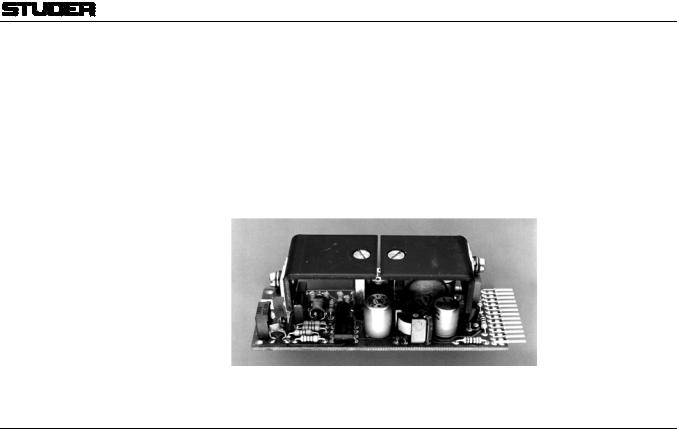
Professional Audio System Components
Loudspeaker Amplifier |
1.914.505 |
|
|
This low-power amplifier on a modular sub-card is designed to drive a 10...15 Ω speaker. Power output is about 2...3 W. As can be concluded from this specification, the amplifier is not intended for high-quality monitoring. It will be ideally suited, however, for pre-fader listening and similar applications. The amplifier’s input is balanced and floating, with adjustable gain.
Technical Specifications
Input impedance |
> 10 kΩ, balanced and floating (with transformer) |
|
Nominal power output |
2 W into 15 Ω |
|
Power output |
25 mW...2.5 W into 15 Ω, with 0 dBu input |
|
Distortion |
< 0.5% at 2 W |
|
|
< 0.15% at 500 mW |
|
S/N |
99 dB, ref. to 2 W at max. gain |
|
Frequency response |
–0.5 dB at 15 kHz |
|
High pass filter |
150 Hz, 12 dB/oct. |
|
Supply: |
–24 V (40 mA idling, max. 220 mA fully driven) |
|
Dimensions: |
MS-card, 34 × 85 mm |
|
Ordering Information: |
Loudspeaker amplifier |
1.914.505.xx |
Date printed: 11.12.2006
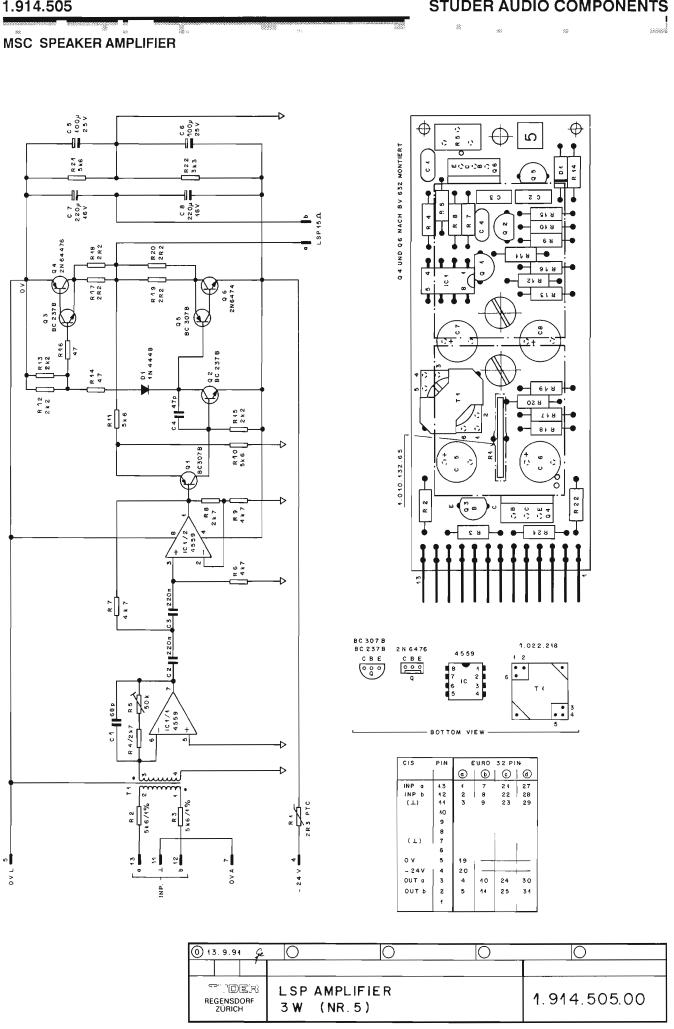
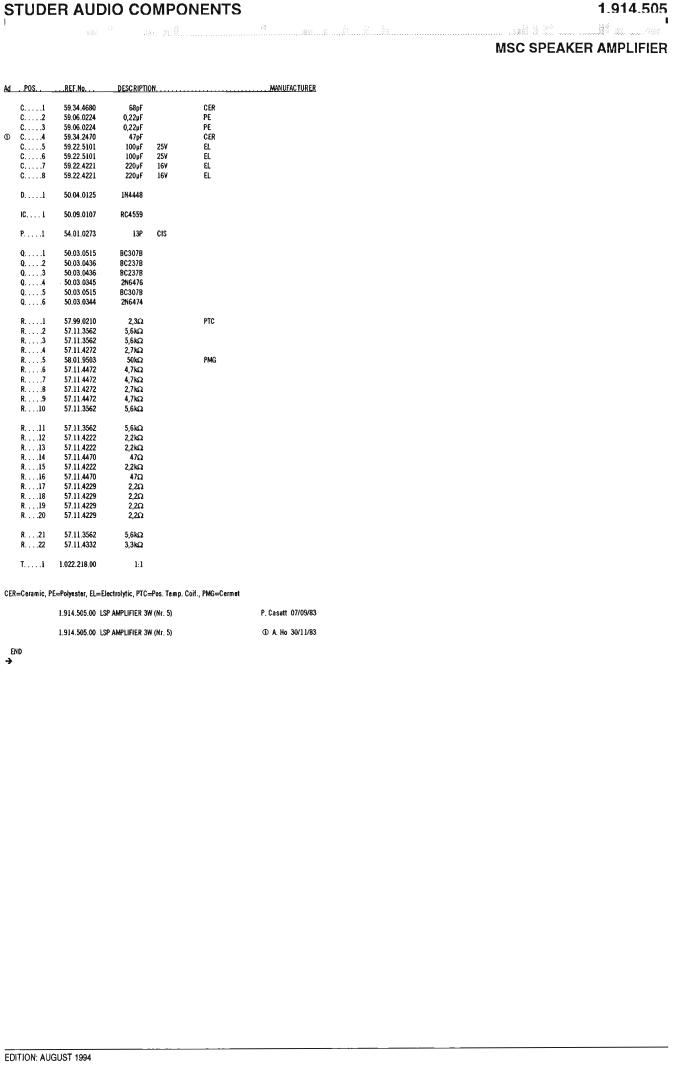
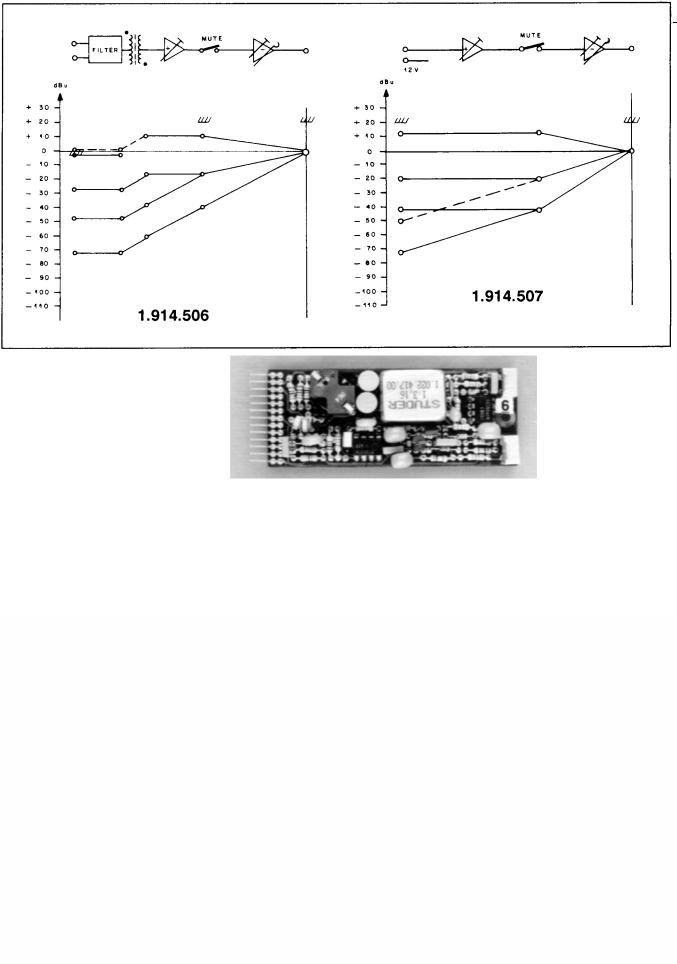
Professional Audio System Components
Microphone Pre-Amplifiers |
1.914.506/507 |
|
|
Two different microphone pre-amplifiers are available, for dynamic or condenser microphones, and for electret microphones. Both offer high gain and low noise, as is required for microphone pre-amplification.
1.914.506 features a balanced and floating input. It is designed for dynamic or condenser microphones with a source impedance of 200 Ω or less. An RF filter is incorporated at the input transformer’s primary. Furthermore, the input is equipped with the resistors required for phantom powering of condenser microphones.
1.914.507 is designed for unbalanced electret microphones requiring a 12 V supply.
A wide range of input levels can be accommodated (see level diagram).
By using the same solid-state switching circuit as can be found in the line and high-level amplifiers, remote muting or activation of a fixed amount of attenuation are possible as well.
The amplifier’s two outputs are unbalanced, with impedances of 3.3 kΩ or 33 Ω, respectively.
Date printed: 11.12.2006

Professional Audio System Components
Technical Specifications
Input: |
|
Transformer-balanced and floating, with RF filter |
(1.914.506) |
|
|
Unbalanced, with RF filter and electret supply |
(1.914.507) |
|
Impedance |
> 1 kΩ, for microphones with an impedance of 200 Ω or less. |
|
Max. input level |
–2 dBu (615 mVrms); THD at 30 Hz: approx. 1% |
|
|
Common mode rejection |
> 60 dB, unbalanced, to ground |
|
|
Output: |
Max. level |
+20 dBu (7.75 Vrms) |
|
Nominal level |
0 dBu (0.775 Vrms) |
|
|
|
Impedance |
33 Ω (pin1) |
|
|
|
3.3 kΩ (pin2; to a 0-Ω amp.) |
|
Minimum load |
600 Ω |
|
|
|
Max. gain |
71 dB (see level diagram) |
|
Frequency response |
±0.5 dB, 30 Hz...16 kHz |
|
|
|
THD |
< 0.3%, 30 Hz...16 kHz at 20 dB gain |
|
Noise figure, linear |
< 4.5 dB, input terminated with 200 Ω |
|
|
Supply: |
|
±15 V (11 mA idling) |
|
|
|
+48 V (1.914.506, only if phantom powering required) |
|
Dimensions: |
|
MS-card, 34 × 85 mm |
|
Ordering Information: |
• |
Microphone pre-amplifier for dynamic microphones |
1.914.506.xx |
|
• |
Microphone pre-amplifier for electret microphones |
1.914.507.xx |
Date printed: 11.12.2006
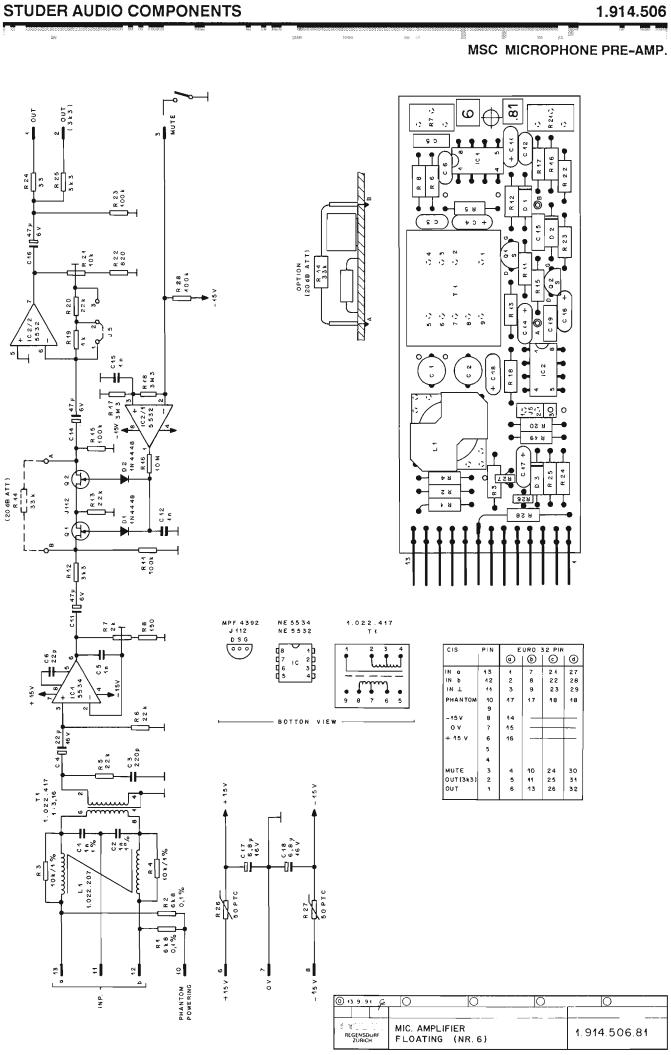
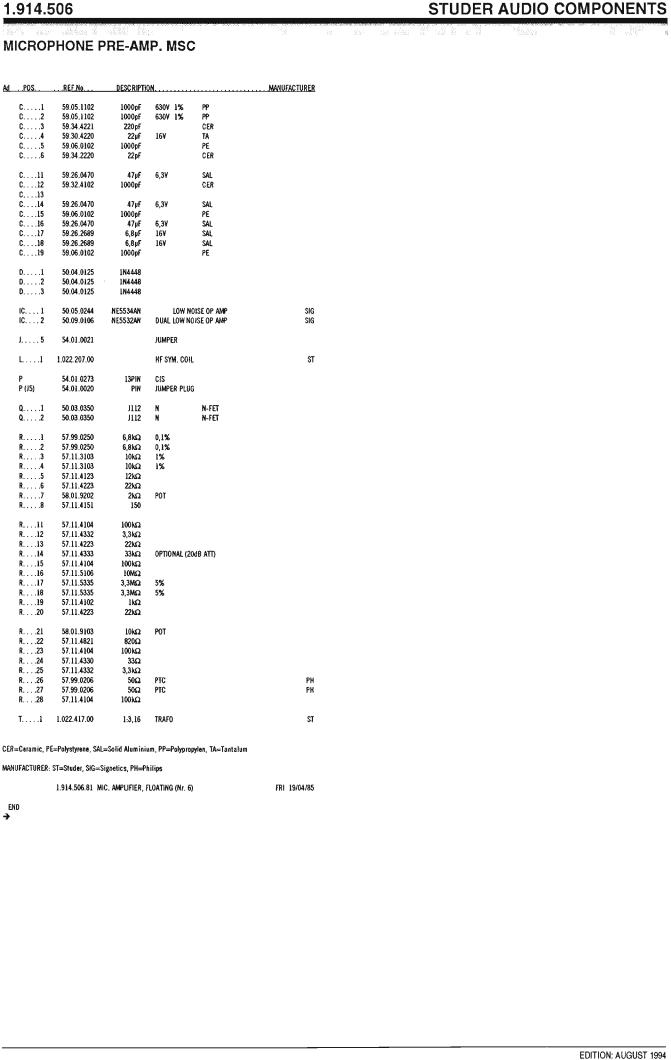
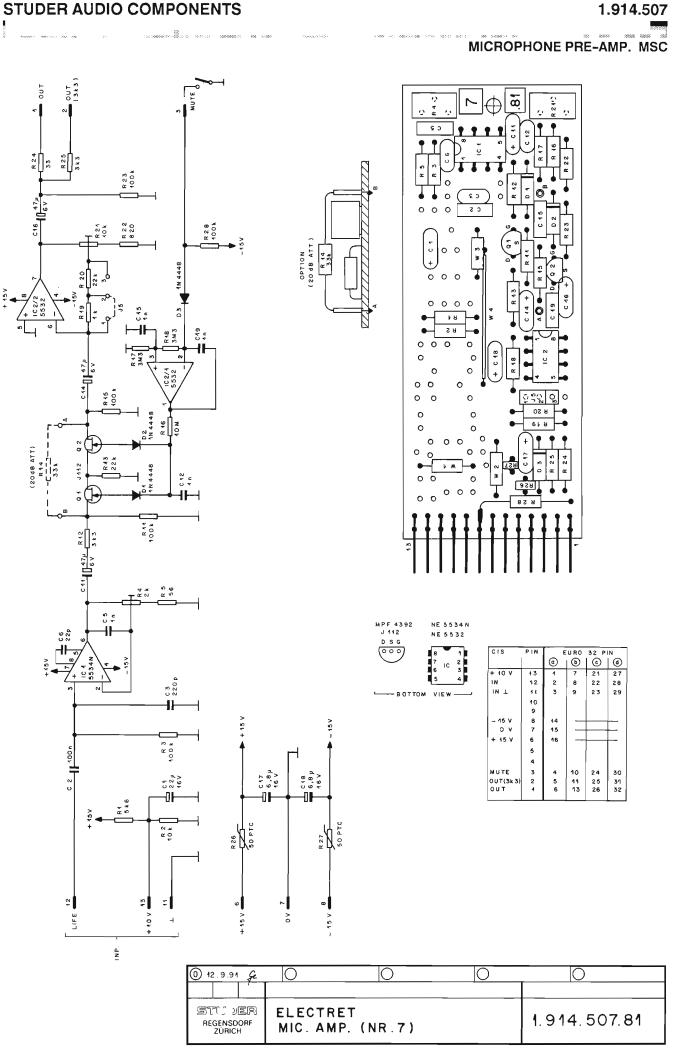
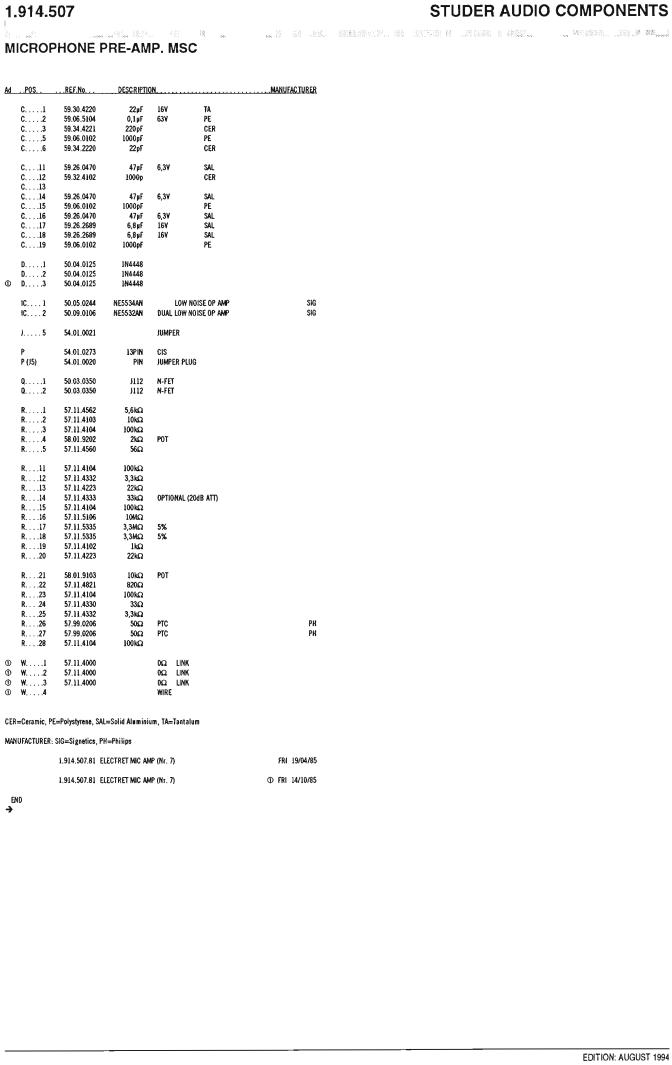
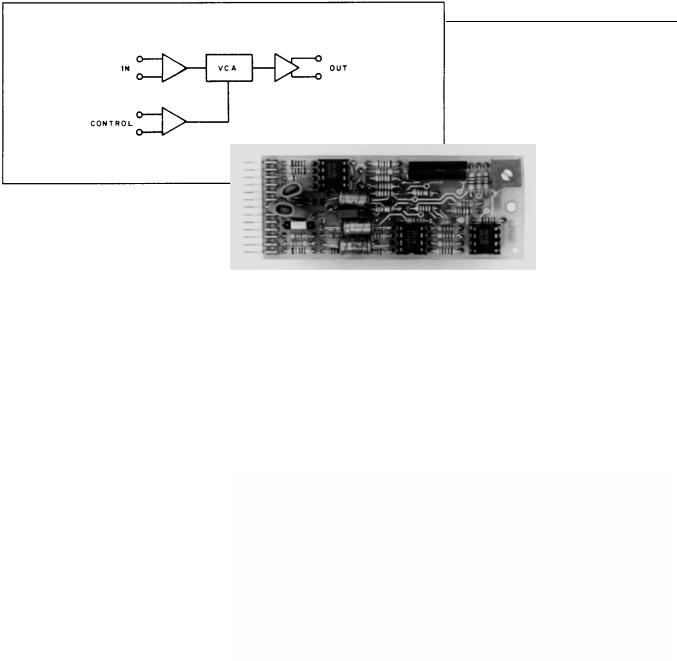
Professional Audio System Components
VCA with Electronically Balanced Connections |
1.914.515 |
|
|
In contrast to the VCA module 1.914.518/528, this assembly features electronically balanced input and output.
It is intended for use in balanced audio systems for a variety of applications, especially when gain is to be controlled from a remote point. It will be useful in audio-video post-production work where suitable DC ramps can control cross-fades, voice-overs, etc. Its high overload margin and its exceptionally low noise and distortion performance make it the perfect choice for high-quality audio applications.
By connecting the gain control terminals of a number of VCAs to a common potentiometer or fader, several audio channels may thus be controlled simultaneously.
Two control inputs provide VCA gain control from two different remote points
Date printed: 12.12.2006

Professional Audio System Components
Technical Specifications
Input: |
Impedance |
≥ 10 kΩ, electronically balanced |
|
|
Clipping point |
+24 dBu |
|
Output: |
|
Electronically balanced |
|
|
Recommended load |
≥ 2 kΩ |
|
|
Maximum level |
+24 dBu |
|
|
Frequency response |
–0.5 dB, 30 Hz...15 kHz |
|
|
Gain/attenuation range |
+40...–100 dB, with ext. control |
|
Control input: pin1; gain tracking |
0 V = unity gain; |
|
|
|
|
1 dB/µA; jumper 1-2 |
|
|
|
20 dB/V; jumper 2-3 |
|
|
|
10 dB/V; jumper 3-4 |
|
Control input: pin10; gain tracking |
10 dB/V |
|
|
|
THD |
< 0.1% |
|
|
Equivalent input noise |
–93 dBu @ unity gain |
|
Supply: |
|
±15 V (25 mA) |
|
Dimensions: |
MS-card, 34 × 85 mm |
|
|
Ordering Information: |
VCA with electronically balanced input and output |
1.914.515.xx |
|
Date printed: 11.12.2006
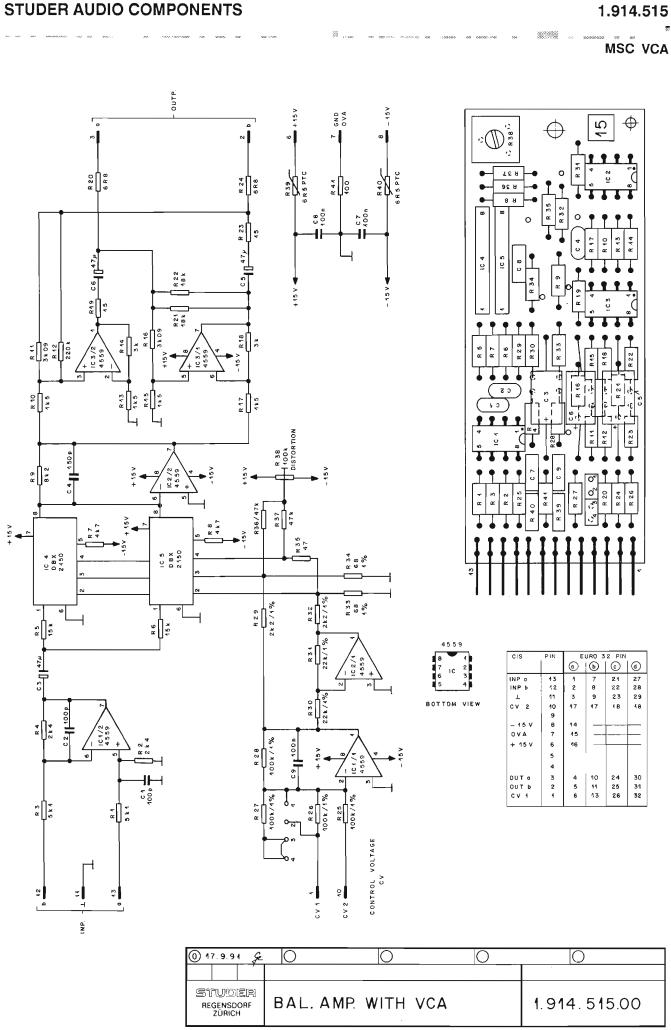
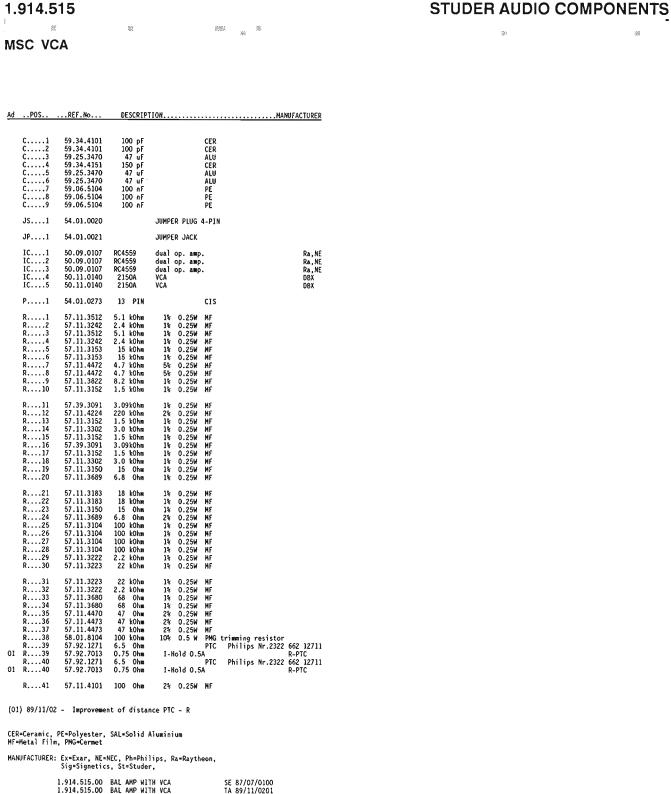
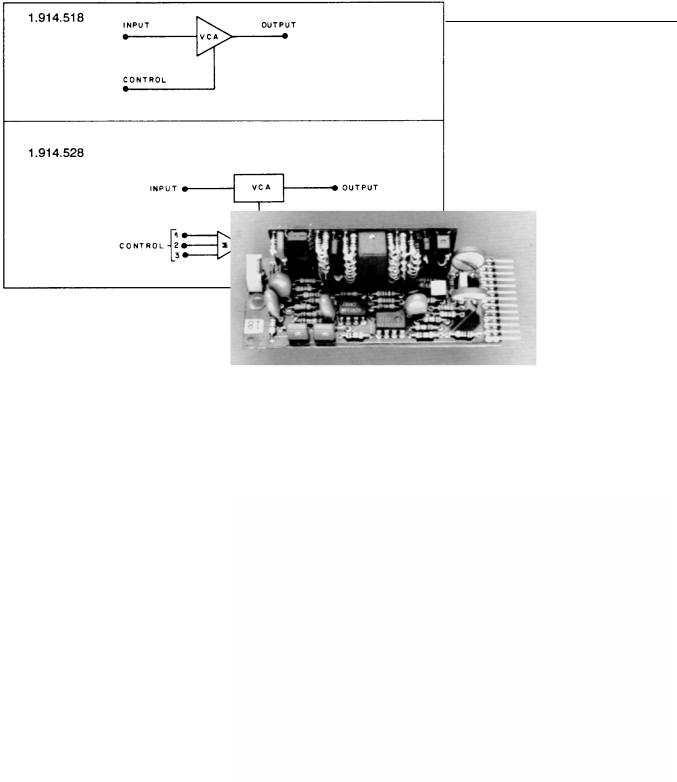
Professional Audio System Components
VCA with 1 or 3 Control Ports |
1.914.518/528 |
|
|
Within the range of modular sub-cards, two more VCAs are available. Voltage controlled amplifiers are ideally suited for applications such as remote level control, level limiting (in combination with the voltage processor 1.914.519) or for automatic “voice-over” circuits, when driven by suitable ramp generators. These VCAs offer outstandingly low noise and harmonic distortion.
For best performance, they should be operated at a level of 0 dBu.
Gain pre-selection is possible on the 1.914.518 version, allowing gain/attenuation ranges either from +10 to –90 dB or from +40 to –70 dB, using an external potentiometer.
The 1.914.528 VCA card differs in that it is equipped with three external control inputs, providing gain control from three different locations.
Date printed: 11.12.2006

Professional Audio System Components
Technical Specifications
Input: |
Impedance |
> 3 kΩ |
|
|
Clipping point |
+20 dBu |
|
Output: |
Impedance |
33 Ω or 3.3 kΩ, selectable |
|
|
Max. level |
+20 dBu |
|
|
Recommended load |
≥ 2 kΩ |
|
|
Frequency response |
–0.5 dB, 30 Hz...16 kHz |
|
|
External gain control |
+40...–90 dB (1.914.518.xx) |
|
|
|
+40...–100 dB (1.914.528.xx) |
|
Gain/attenuation range (pot. meter) |
+40...–60 dB / +10...–70 dB / +10...–90 dB (1.914.518.xx only, jumper- |
||
|
|
selectable) |
|
|
Gain tracking |
10 dB/V |
|
|
THD |
< 0.1% |
|
|
Equivalent input noise |
–102 dBu |
|
Supply: |
|
±15 V (40 mA) |
|
Dimensions: |
|
MS-card, 34 × 85 mm |
|
Ordering Information: |
Voltage controlled amplifier with 1 control port |
1.914.518.xx |
|
|
|
Voltage controlled amplifier with 3 control ports |
1.914.528.xx |
Date printed: 11.12.2006
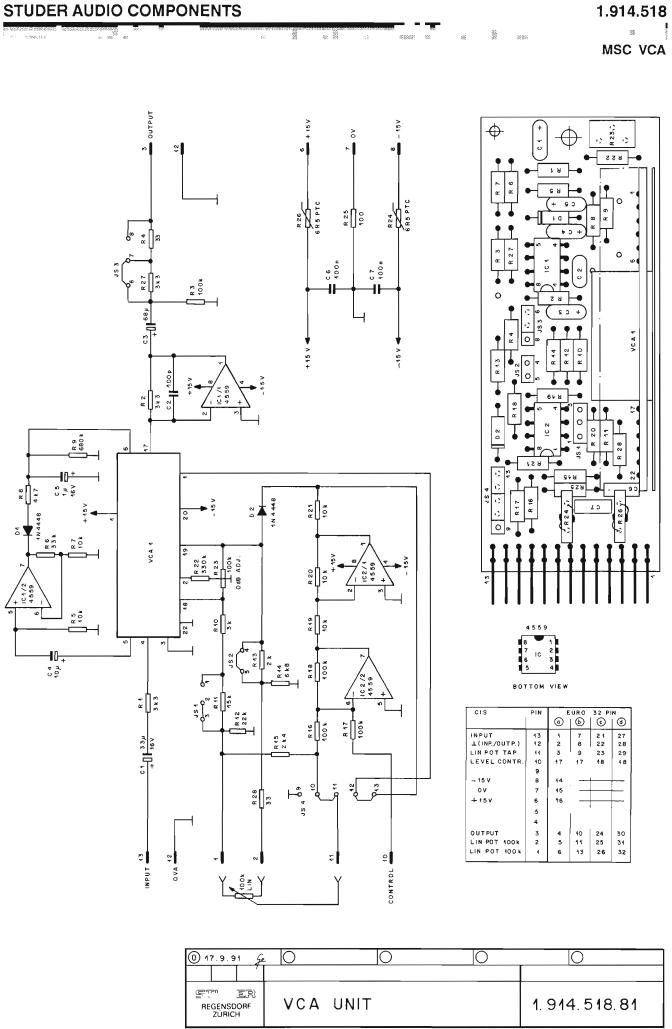
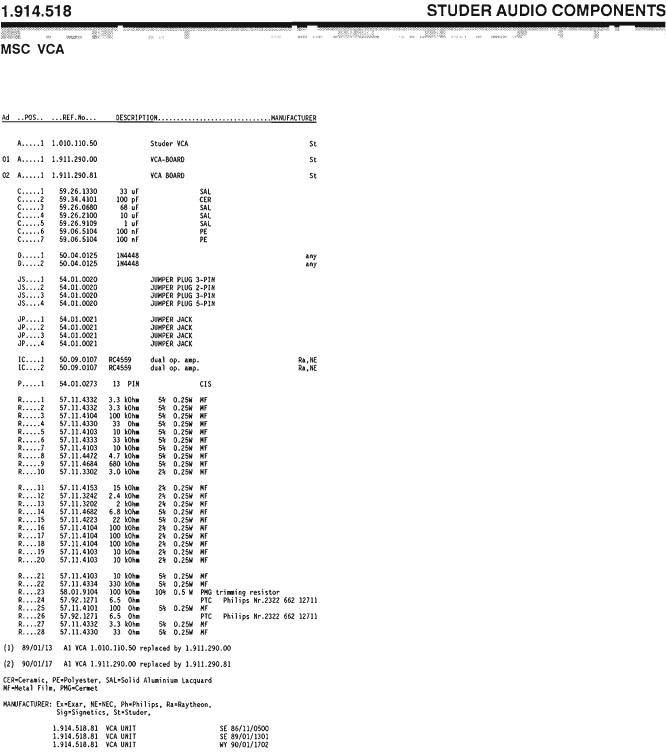
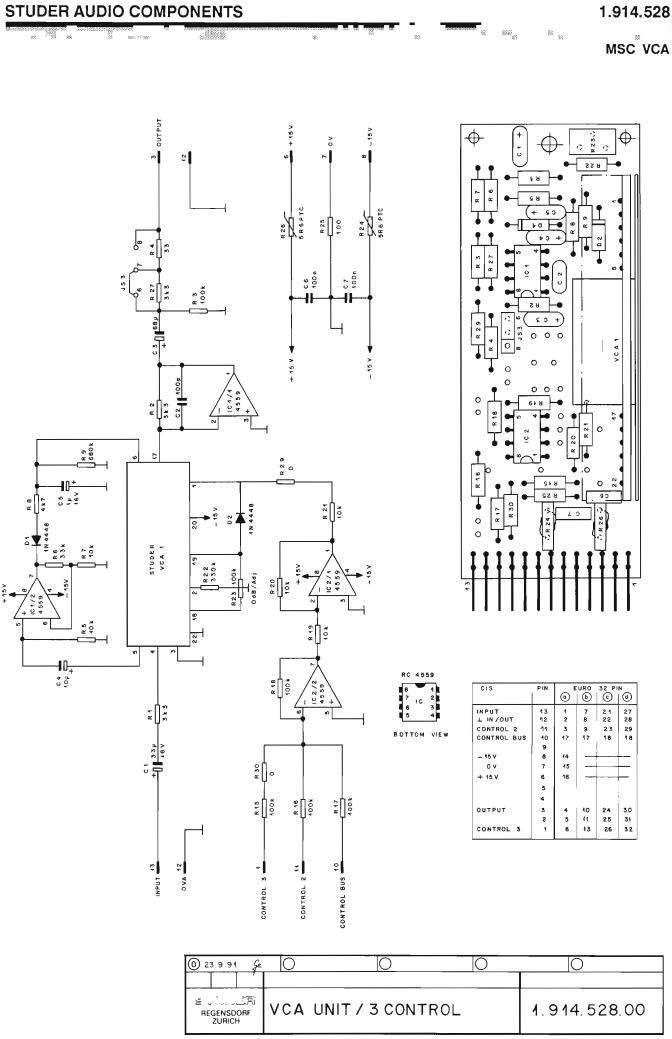
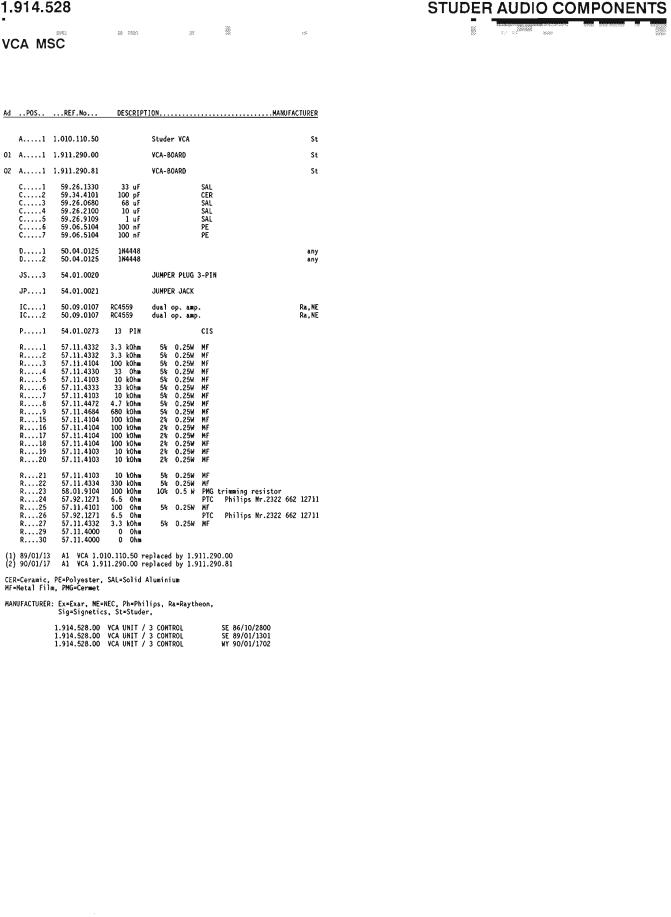
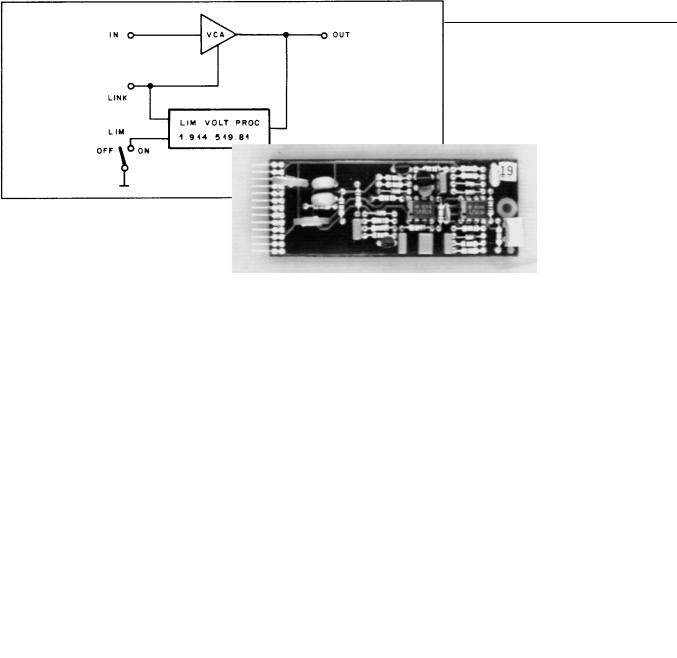
Professional Audio System Components
Limiter Voltage Processor |
1.914.519 |
|
|
Together with this voltage processor, the VCAs 1.914.518/528 can perform as signal level limiters.
The processor’s threshold can be set within a wide range of levels, so that limiting action becomes effective at a desired level within a range of –15 to +15 dBu. Limiting action attacks within 1 ms, whereas release can vary from 50 ms to 5 s, depending on the program’s energy content. This means that no audible “pumping” action – which is often associated with such a device – will occur. After the cessation of loud passages, amplification will recover only slowly. For stereo applications, a two-channel set-up (VCAs and voltage processor) can be linked, so that identical amounts of gain reduction will take place simultaneously in both channels.
The input of the voltage processor has to be wired to the output of the VCA. The processor’s output, when connected to the VCA’s control terminal, will effect the necessary gain reduction so that a limiting characteristic is obtained. The limiting threshold is adjustable in a wide range. Remote on/off switching of the limiter function is possible.
Date printed: 11.12.2006

Professional Audio System Components
Technical Specifications
Limiter: |
Input impedance |
≥ 10 kΩ |
|
|
Max. input level |
+20 dBu |
|
|
Frequency range |
30 Hz...16 kHz |
|
|
Output voltage |
0...–13 VDC |
|
|
Threshold level |
–15 dBu...+15 dBu |
|
|
Attack time |
1 ms |
|
|
Release time |
50 ms...5 s, program-depending |
|
|
Compression ratio |
20:1, in conjunction with a VCA |
|
Supply: |
|
±15 V (10 mA) |
|
Dimensions: |
|
MS-card, 34 × 85 mm |
|
Ordering Information: |
Limiter voltage processor |
1.914.519.xx |
|
Date printed: 11.12.2006
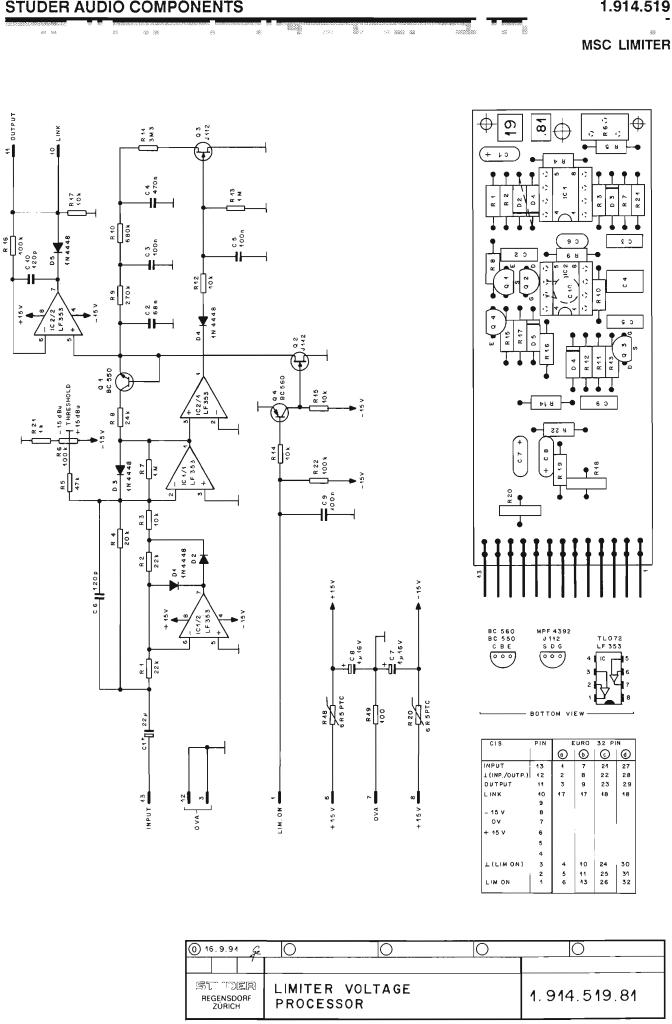
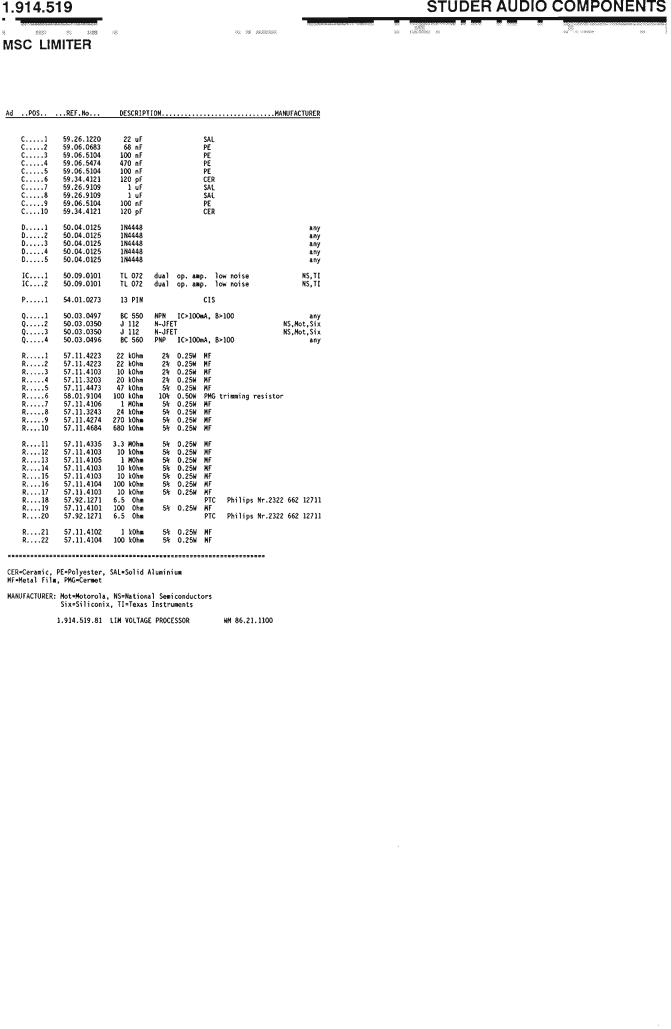
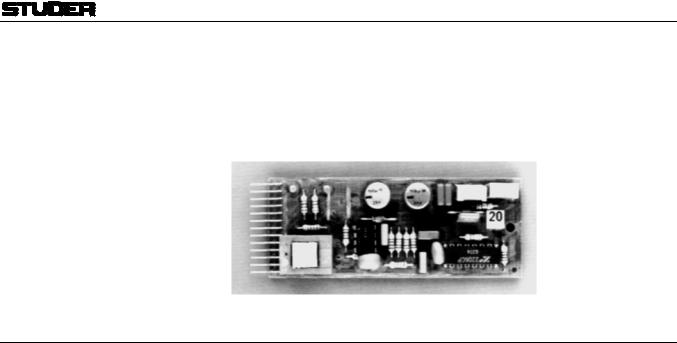
Professional Audio System Components
1900 Hz Signal Generator |
1.914.520 |
|
|
This signal generator produces a stable frequency of 1900 Hz to establish communication on outside broadcast lines, as specified in the EBU/CCIR recommendations.
Technical Specifications
Frequency |
1900 Hz (adjustable) |
|
Distortion |
< 1% |
|
Output level |
–15...+6 dBu (adjustable) |
|
Output |
balanced and floating |
|
Output Impedance, out 1 |
< 15 Ω |
|
out 2 |
600 Ω |
|
Minimum load |
200 Ω |
|
Supply: |
±15 V (20 mA) |
|
Dimensions: |
MS-card, 34 × 85 mm |
|
Ordering Information: |
1900 Hz signal generator |
1.914.520.xx |
Date printed: 11.12.2006
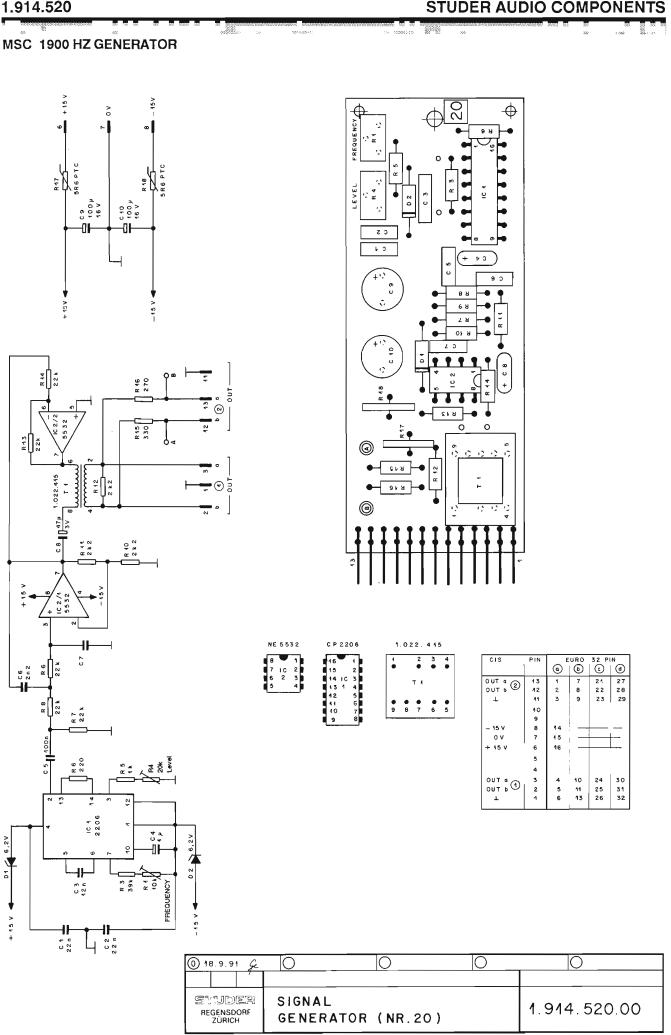
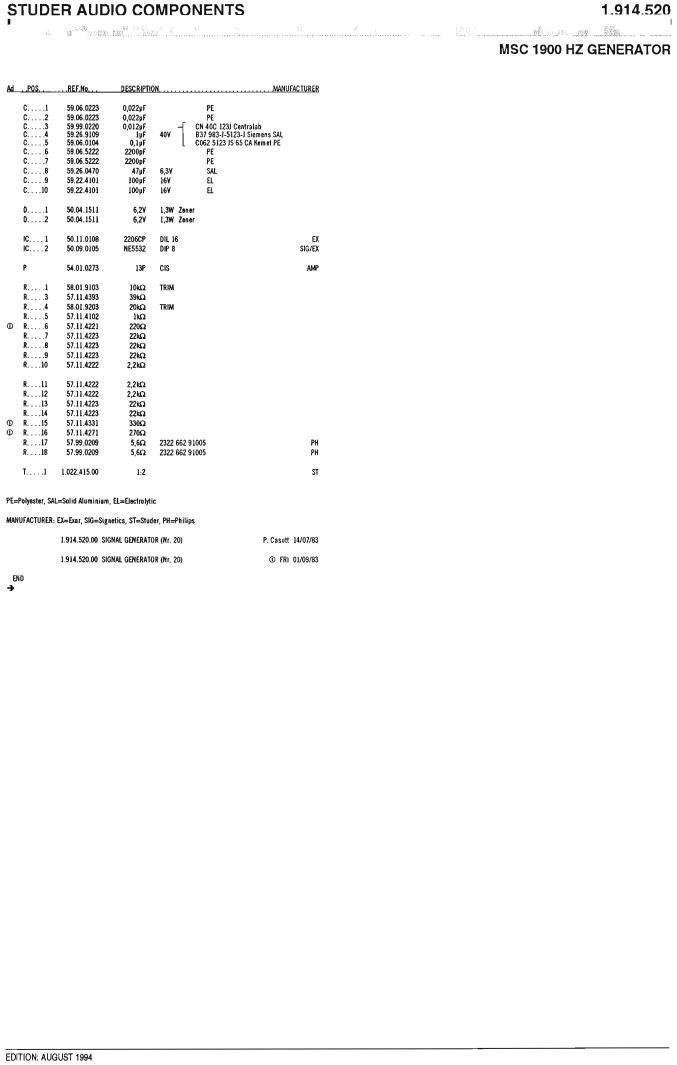
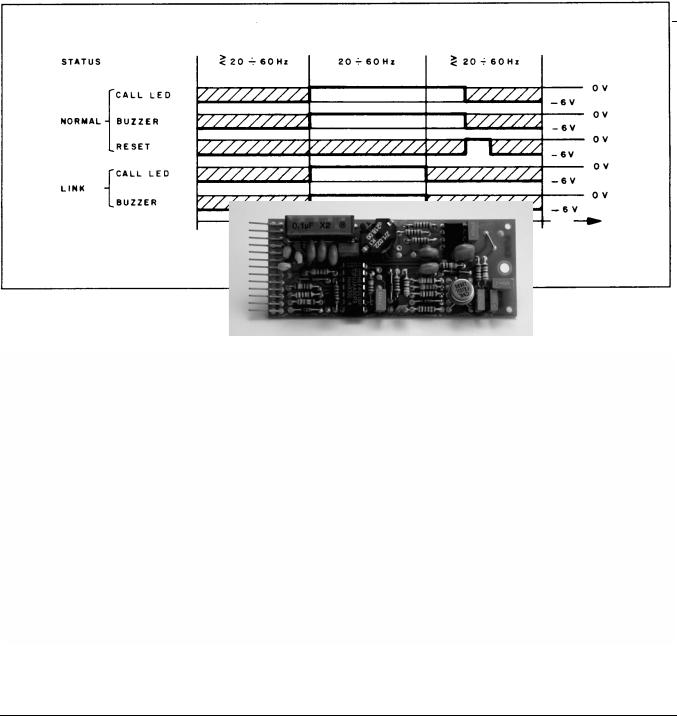
Professional Audio System Components
Call Decoder 20...60 Hz |
1.914.521 |
|
|
This assembly features a call receiver for the ringing frequency on telephone lines (20...60 Hz). The receiver can activate an optical and/or an acoustical signal generated by an external buzzer (not supplied). In normal mode the buzzer will be on until reset. In linked mode the signal lasts only as long as a call is detected.
Technical Specifications
Input: |
balanced, floating; no DC |
|
Impedance |
> 20 kΩ |
|
Frequency |
20...60 Hz |
|
Min. level |
17 Vrms |
|
Nominal level |
70 Vrms |
|
Supply: |
+15 V (5 mA); –15 V (10 mA); –6 V (2 mA) |
|
Dimensions: |
MS-card, 34 × 85 mm |
|
Ordering Information: |
Call decoder 20...60 Hz |
1.914.521.xx |
Date printed: 11.12.2006
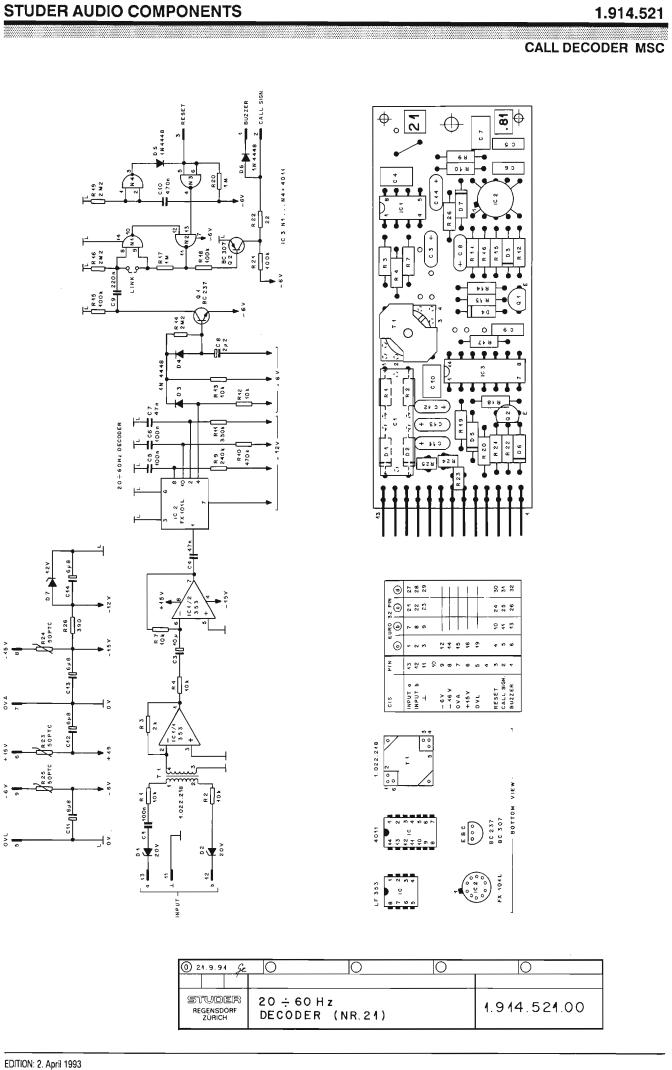

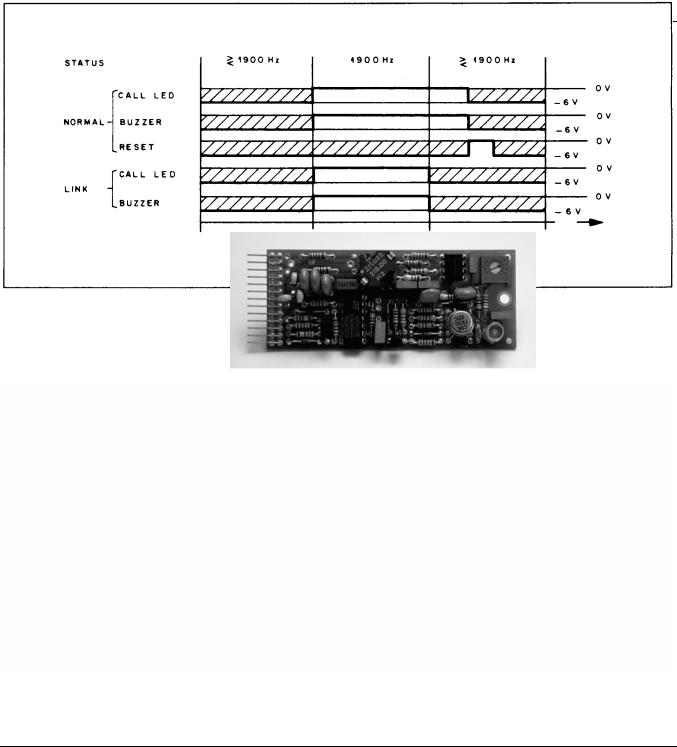
Professional Audio System Components
Call Decoder 1900 Hz |
1.914.522 |
|
|
This card contains a call receiver for the standardized 1900 Hz call frequency on OB lines. It is tuned to respond to 1900 Hz ±1 %. The receiver can be switched either to activate an optical or an acoustical signal for the duration of the 1900 Hz call (linked mode), or the acoustical signal can be selected to remain activated until reset (normal mode).
The acoustical signal can be generated by an external buzzer (not supplied).
Technical Specifications
Input: |
balanced, floating; no DC |
|
Frequency |
1900 Hz, ±1% |
|
Impedance |
> 10 kΩ |
|
Min. level |
–30 dBu |
|
Nominal level |
+24 dBu |
|
Supply: |
+15 V (5 mA); –15 V (10 mA); –6 V (2 mA) |
|
Insulation rating |
500 VDC |
|
Dimensions: |
MS-card, 34 × 85 mm |
|
Ordering Information: |
Call decoder 1900 Hz |
1.914.522.xx |
Date printed: 11.12.2006
